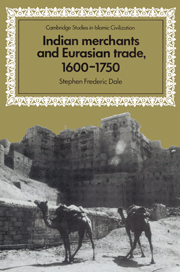Book contents
- Frontmatter
- Contents
- List of illustrations
- Preface
- Note on transliteration
- Abbreviations
- 1 An Indian world economy
- 2 India, Iran and Turan in 1600
- 3 The Indian diaspora in Iran and Turan
- 4 Indo-Russian commerce in the early modern era
- 5 The Indian diaspora in the Volga basin
- 6 Imperial collapse, mercantilism and the Mughul diaspora
- Appendix
- Bibliography
- Index
2 - India, Iran and Turan in 1600
Published online by Cambridge University Press: 22 September 2009
- Frontmatter
- Contents
- List of illustrations
- Preface
- Note on transliteration
- Abbreviations
- 1 An Indian world economy
- 2 India, Iran and Turan in 1600
- 3 The Indian diaspora in Iran and Turan
- 4 Indo-Russian commerce in the early modern era
- 5 The Indian diaspora in the Volga basin
- 6 Imperial collapse, mercantilism and the Mughul diaspora
- Appendix
- Bibliography
- Index
Summary
In the beginning of the month of Day [October 1615] merchants came from Persia and brought pomegranates of Yazd and melons from Kariz, which are the best of the Khurasan melons … As my revered father (may God's light be his witness!) had a great liking for fruit I was very grieved that such fruits had not come to Hindustan in his victorious time.
The Mughul emperor Jahangir: Tuzuk-i Jahangiri, I, 270The composition of Mughul India's trade with Safavid Iran and Uzbek Turan was determined primarily by contrasts between its economy and those of these two contiguous states, while the volume of exchange was influenced both by supply and demand and the commercial policies and political stability of their dynasties. Mughul India possessed vastly greater natural and human resources than did Safavid and Uzbek territories; its economy also overshadowed its neighbors in terms of its overall size, diversity and sophistication. There was a consistent demand for Mughul India's natural and manufactured products in Iran and Turan, and the level of commerce was catalyzed in the second half of the sixteenth century by the achievements of two exceptionally able Mughul and Safavid rulers. These were the Mughul emperor Akbar (1556–1605) and the Safavid shah ‘Abbas (1587–1629). Both men stimulated internal and external commerce by consolidating their dynasties’ political authority, and by consciously instituting policies that stimulated trade.
- Type
- Chapter
- Information
- Indian Merchants and Eurasian Trade, 1600–1750 , pp. 14 - 44Publisher: Cambridge University PressPrint publication year: 1994



